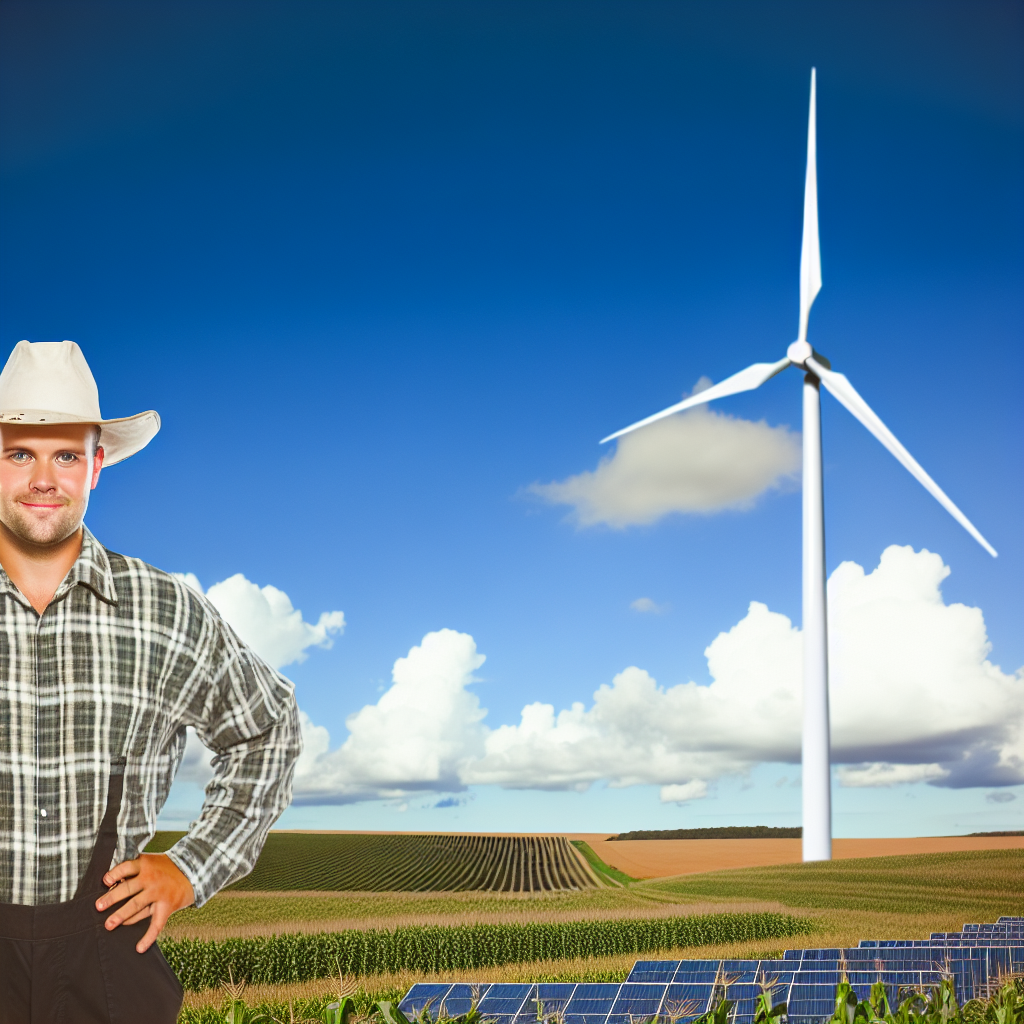Introduction to Renewable Energy and its Importance for Small Farms
Renewable energy offers significant benefits for small farms.
It can reduce reliance on fossil fuels and lower operating costs.
Furthermore, transitioning to renewable energy enhances environmental sustainability.
Small farms often face unique challenges in energy consumption.
Traditional energy sources may be expensive and unreliable.
As a result, farmers are increasingly seeking alternative energy solutions.
Benefits of Renewable Energy for Small Farms
Utilizing renewable energy can lead to substantial cost savings.
Farmers can generate their energy through solar panels and wind turbines.
This initiative not only reduces utility bills but also increases self-sufficiency.
Moreover, using green energy enhances the farm’s marketability.
Consumers increasingly prefer products from environmentally friendly operations.
Challenges in Implementing Renewable Energy
Small farms may encounter financial barriers when adopting renewable energy.
Initial setup costs can be a significant obstacle for many farmers.
Additionally, securing funding or grants can be complex and time-consuming.
Farmers may also face technical challenges in implementing new technologies.
Transform Your Agribusiness
Unlock your farm's potential with expert advice tailored to your needs. Get actionable steps that drive real results.
Get StartedTypes of Renewable Energy Suitable for Small Farms
Solar energy is one of the most accessible options for small farms.
It can be harnessed through photovoltaic panels.
Wind energy is another viable alternative, especially in open fields.
Geothermal systems can provide heating solutions for greenhouses and livestock.
Biomass energy can also play a role, utilizing waste materials effectively.
Adoption Strategies for Small Farms
Education is crucial for farmers considering renewable energy options.
Workshops and online resources can provide valuable information.
Collaboration with local governments and organizations can offer support.
Farmers should explore funding opportunities and incentives available.
Moreover, joining cooperative programs can lower individual costs.
Overview of Different Types of Renewable Energy Sources
Solar Energy
Solar energy harnesses the power of the sun to generate electricity.
This technology uses photovoltaic cells in solar panels.
Farmers can install these panels on rooftops or open fields.
Additionally, solar thermal systems can be used for heating needs.
Both methods reduce reliance on fossil fuels.
Wind Energy
Wind energy utilizes the movement of air to produce electricity.
Wind turbines convert wind kinetic energy into electrical energy.
Small farms can install individual turbines for power generation.
These turbines can significantly lower energy costs.
They contribute to a cleaner energy mix as well.
Hydropower
Hydropower harnesses the energy from flowing water.
It typically involves using a stream or river on the farm.
Small-scale systems can be installed for personal use.
This renewable source can provide a consistent energy supply.
Showcase Your Farming Business
Publish your professional farming services profile on our blog for a one-time fee of $200 and reach a dedicated audience of farmers and agribusiness owners.
Publish Your ProfileHydropower systems have a low environmental impact when designed properly.
Biomass Energy
Biomass energy is derived from organic materials.
Common sources include crop residues, manure, and food waste.
Farmers can convert these materials into bioenergy.
This process not only generates power but also reduces waste.
It promotes circular economy practices on small farms.
Geothermal Energy
Geothermal energy taps into the Earth’s internal heat.
This renewable resource can heat spaces and water efficiently.
Farmers in suitable locations can install geothermal heating systems.
These systems reduce dependency on conventional heating methods.
Overall, geothermal energy proves to be a reliable energy source.
Assessing Energy Needs and Potential on Small Farms
Understanding Current Energy Usage
Small farms often rely on diverse energy sources.
Farmers must identify their current energy consumption.
This process begins with an energy audit.
Data collection on usage patterns is crucial.
Consider each aspect of farm operations.
Lighting, machinery, and heating contribute to energy needs.
Farmers should monitor monthly energy bills for insights.
Identifying peak consumption times helps in planning.
Evaluating Renewable Energy Opportunities
After assessing current needs, explore renewable energy options.
Solar power is a popular choice among small farms.
Farmers can install solar panels on unused land.
Wind energy presents another potential source.
Wind turbines can be beneficial in open areas.
Consider biomass energy from agricultural waste too.
Utilizing waste reduces disposal costs and environmental impact.
Calculating Potential Savings
It’s essential to quantify potential savings from renewables.
Farmers should analyze installation costs versus long-term benefits.
Financial calculations can help in decision-making.
Look into government grants and tax incentives available.
These incentives can offset initial investment costs.
Evaluate total payback time based on energy savings.
Creating an Energy Management Plan
Developing a comprehensive energy management plan is key.
This plan should include timelines and clear objectives.
Involve all family members in this planning process.
Training on energy efficiency practices enhances engagement.
Regular reviews of energy usage and adjustments are necessary.
Staying flexible allows farmers to adapt to changing technologies.
Engaging with Energy Experts
Consulting with energy experts brings additional insights.
Many organizations offer resources tailored to small farms.
Showcase Your Farming Business
Publish your professional farming services profile on our blog for a one-time fee of $200 and reach a dedicated audience of farmers and agribusiness owners.
Publish Your ProfilePartnerships with local universities can provide valuable data.
Engagement with the community fosters collaborative solutions.
Networking with other farmers can share innovative ideas.
Attend workshops focused on renewable energy applications.
Explore Further: Organic Farming Techniques For Sustainability
Solar Energy: Installation, Costs, and Benefits for Small Farmers
Understanding Solar Energy Installation
Installing solar panels requires careful planning and site assessment.
Farmers must identify suitable locations for solar installations.
Optimal site conditions enhance energy production and efficiency.
The installation process involves both hardware and software solutions.
Choosing high-quality solar panels can impact long-term performance.
Additionally, working with experienced contractors ensures quality installation.
Evaluating Costs Associated with Solar Energy
Initial costs for solar energy systems can be significant.
However, various financing options are available for farmers.
Many local and federal programs offer grants and tax incentives.
Over time, solar energy reduces electricity bills and operational costs.
Farmers should calculate potential returns on investment carefully.
Benefits of Solar Energy for Small Farms
Solar energy provides numerous advantages for small farmers.
First, it enhances energy independence, reducing reliance on external suppliers.
Second, solar energy contributes to sustainability and environmental responsibility.
Third, it can improve profitability by lowering operational expenses.
Moreover, renewable energy supports local economies through job creation.
Long-Term Considerations for Implementation
Small farmers should consider future expansion of solar systems.
Monitoring energy production ensures optimal performance over time.
Additionally, regular maintenance prolongs the life of solar installations.
Farmers must stay informed about evolving technology and regulations.
This knowledge can influence decisions related to solar energy systems.
Uncover the Details: Seasonal Planning Tips for Community Supported Agriculture
Wind Energy: Harnessing Wind Power and Its Viability in Agriculture
Understanding Wind Energy
Wind energy is a powerful renewable resource.
It converts the kinetic energy of wind into electricity.
This form of energy is increasingly popular among small farmers.
Benefits of Wind Energy for Small Farms
Wind energy offers several advantages for agriculture.
First, it reduces reliance on fossil fuels.
This leads to lower energy costs over time.
Additionally, wind turbines require minimal maintenance.
Finally, they can operate efficiently in various locations.
Assessing Wind Energy Viability
Evaluating wind energy’s feasibility begins with site assessment.
Farmers should analyze wind speed and direction.
They can use anemometers to gather precise data.
Moreover, local regulations impact installation decisions.
Therefore, consulting local authorities is essential.
Showcase Your Farming Business
Publish your professional farming services profile on our blog for a one-time fee of $200 and reach a dedicated audience of farmers and agribusiness owners.
Publish Your ProfileChoosing the Right Wind Turbine
Selecting a suitable wind turbine is crucial for success.
Farmers must consider turbine size based on energy needs.
Horizontal-axis turbines are common and efficient.
Alternatively, vertical-axis turbines suit small spaces better.
Financial Incentives and Support
Government programs often provide financial assistance.
Farmers can access grants or tax credits for installations.
Investing in wind energy can yield significant long-term savings.
Challenges of Implementing Wind Energy
Wind energy implementation does come with challenges.
Initial costs for equipment and installation can be high.
Additionally, aesthetic concerns may arise among neighbors.
Lastly, environmental impacts must be taken into account.
Learn More: Planning Successful Agri-Tourism Events on Your Farm
Biogas Production: Utilizing Agricultural Waste for Energy
Understanding Biogas
Biogas is a renewable energy source from organic materials.
It mainly consists of methane and carbon dioxide.
This process occurs during anaerobic digestion.
Farmers can easily implement it on small farms.
Benefits of Biogas Production
Using agricultural waste for energy offers numerous advantages.
First, it reduces waste disposal costs for farmers.
Second, biogas production enhances soil health.
Furthermore, it decreases greenhouse gas emissions.
Finally, it provides an additional income stream for farmers.
Materials for Biogas Production
Farmers can use various organic materials to create biogas.
Common inputs include livestock manure and crop residues.
Additionally, food waste is an excellent resource.
Using diverse materials improves biogas yield.
Setting Up a Biogas System
Establishing a biogas system requires careful planning.
First, farmers must choose the right site for a digester.
Next, they should evaluate the types of waste available.
Additionally, selecting the right technology is essential.
Finally, ongoing maintenance ensures optimal performance.
Biogas Utilization
Farmers can use biogas in multiple ways.
They can generate electricity for farm operations.
Moreover, biogas can be used for heating purposes.
Some farmers even use it as a vehicle fuel.
These applications enhance farm sustainability and efficiency.
Challenges and Considerations
Implementing biogas systems can present challenges.
Initial setup costs may deter some farmers.
Moreover, knowledge gaps exist regarding maintenance.
Farmers should consider local regulations as well.
Despite these challenges, the benefits often outweigh the drawbacks.
Showcase Your Farming Business
Publish your professional farming services profile on our blog for a one-time fee of $200 and reach a dedicated audience of farmers and agribusiness owners.
Publish Your ProfileExplore Further: Sustainable Harvesting Methods For Farmers

Integrating Renewable Energy Solutions
Combining Solar and Wind Energy
Small farms can significantly benefit from solar and wind energy integration.
Both sources generate clean electricity and reduce energy costs.
Farmers can install solar panels on barn roofs to harness sunlight.
Additionally, wind turbines can be strategically placed around fields.
This combination maximizes energy production throughout the year.
Using Biomass and Geothermal Energy
Biomass energy provides another viable renewable option for small farms.
Farm waste, such as crop residues, can be transformed into biomass fuel.
Meanwhile, geothermal energy utilizes the Earth’s heat for heating and cooling.
Farmers can use geothermal heat pumps to regulate temperatures efficiently.
Consequently, these solutions enhance energy independence.
Creating a Sustainable Energy Mix
A sustainable energy mix optimizes the benefits of multiple sources.
Farmers should evaluate their unique energy needs before implementation.
They can start by analyzing local wind and solar conditions.
Combining different sources allows for energy generation even during bad weather.
This approach minimizes reliance on a single energy type.
Incorporating Energy Storage Solutions
Energy storage plays a crucial role in utilizing renewable sources effectively.
Batteries can store excess energy produced during the day for nighttime use.
Farmers may choose from a variety of energy storage systems available today.
Having reliable storage increases the farm’s energy resilience.
Moreover, it ensures stability in energy supply during peak usage times.
Implementing Smart Energy Management Systems
Adopting smart energy management can optimize energy use on farms.
Smart meters and management apps help monitor energy consumption.
They provide insights into energy usage, fostering informed decisions.
Furthermore, this technology enables real-time adjustments to energy systems.
As a result, farms can enhance their overall efficiency.
Economic Benefits of Renewable Energy for Small Farm Operations
Reducing Energy Costs
Renewable energy significantly lowers energy bills for small farms.
By harnessing solar or wind power, farmers rely less on traditional electricity.
This shift translates to substantial savings over time.
Consequently, these funds can be redirected to enhance farm operations.
Increasing Revenue Opportunities
Small farms can sell surplus energy back to the grid.
This generates additional income streams effortlessly.
Farmers can also participate in local energy co-ops.
These opportunities further diversify their income sources.
Accessing Government Incentives
Many governments offer financial incentives for renewable projects.
Small farms can benefit from grants and tax credits for installation.
These incentives significantly reduce initial setup costs.
As a result, renewable energy becomes a more feasible option.
Enhancing Property Value
Renewable energy installations can increase property values.
Future buyers recognize the long-term savings on energy costs.
Showcase Your Farming Business
Publish your professional farming services profile on our blog for a one-time fee of $200 and reach a dedicated audience of farmers and agribusiness owners.
Publish Your ProfileThis added value makes the property more attractive on the market.
Furthermore, it positions farms positively within their communities.
Mitigating Financial Risk
Renewable energy reduces dependency on fluctuating fuel prices.
Farmers gain stability in their operating costs.
Predictable energy expenses allow better financial planning.
This stability is crucial for long-term agricultural success.
Improving Sustainability Credentials
Utilizing renewable energy enhances a farm’s sustainability profile.
Consumers increasingly prefer products from eco-friendly farms.
Thus, small farms can attract a loyal customer base.
Moreover, sustainable practices bolster brand reputation.
Building Resilience Against Climate Change
Renewable energy sources are crucial for climate resilience.
Farms become less vulnerable to energy disruptions.
These systems support consistent farming operations even during crises.
Ultimately, resilience contributes to long-term economic stability.
Government Incentives and Grants for Renewable Energy Adoption
Overview of Available Programs
Various government programs support renewable energy initiatives.
These programs help small farms reduce energy costs.
Additionally, they encourage the transition to sustainable practices.
Tax Credits and Deductions
Tax credits can significantly offset initial installation costs.
The federal Investment Tax Credit (ITC) offers a percentage of the system cost.
Moreover, some states provide additional incentives for solar energy systems.
Grant Opportunities
Numerous grants exist specifically for renewable energy projects.
The USDA’s Rural Energy for America Program (REAP) is notable.
This program offers financial assistance for renewable energy installations.
Grants can cover up to 25% of associated costs.
Low-Interest Loans
Low-interest loans help farmers finance energy-efficient projects.
The Farm Service Agency (FSA) provides options for these loans.
Such financing often includes favorable repayment terms.
State and Local Incentives
States may have unique incentives tailored for local needs.
Some regions offer incentives based on energy generation capacity.
Farmers should explore their state’s renewable energy programs.
How to Apply for Incentives
Interested farms must follow a structured application process.
First, gather necessary project documentation.
Next, calculate potential costs and benefits.
Finally, submit applications to the appropriate agencies.
Case Studies: Successful Implementation of Renewable Energy on Small Farms
Wind Energy Adoption
A small farm in Nebraska successfully installed wind turbines.
This initiative significantly reduced energy costs.
Farm owner Alice Johnson reported an annual savings of 30%.
Additionally, the turbines provided enough energy to power the entire farm.
Consequently, Alice’s farm became a model for sustainability in her community.
Solar Energy Utilization
The Green Valley Farm embraced solar panels in 2021.
Showcase Your Farming Business
Publish your professional farming services profile on our blog for a one-time fee of $200 and reach a dedicated audience of farmers and agribusiness owners.
Publish Your ProfileOwner Mark Stevens installed 50 solar panels on his barn roof.
This upgrade generated excess energy for the grid.
Mark’s farm now contributes to local renewable energy efforts.
Moreover, his electricity bills decreased by 40%.
Biogas Production
Sunny Acres Farm utilized farm waste to produce biogas.
Owner Priya Patel constructed a biogas digester on-site.
This innovation converted livestock manure into clean energy.
As a result, the farm met its heating and cooking energy needs.
Furthermore, Priya has reduced greenhouse gas emissions significantly.
Hydroponic Greenhouses Powered by Renewable Energy
Open Fields Farm integrated a hydroponic greenhouse system.
Owner Tom Robinson used solar energy for lighting and irrigation.
This combination increased crop yield while minimizing resource use.
Tom reported a 25% increase in profits since the switch.
The hydroponic system also offered a steady supply of fresh produce year-round.
Community Support and Government Incentives
Community ties strengthened as local farms adopted renewable energy.
To further this growth, the government provided tax incentives.
Local organizations hosted workshops on renewable energy solutions.
Farmers learned about funding options and installation processes.
This collective effort enhanced regional sustainability initiatives.
Additional Resources
Tidal and Wave Renewable Energy
Environmental Impacts of Wind Power | Union of Concerned Scientists




